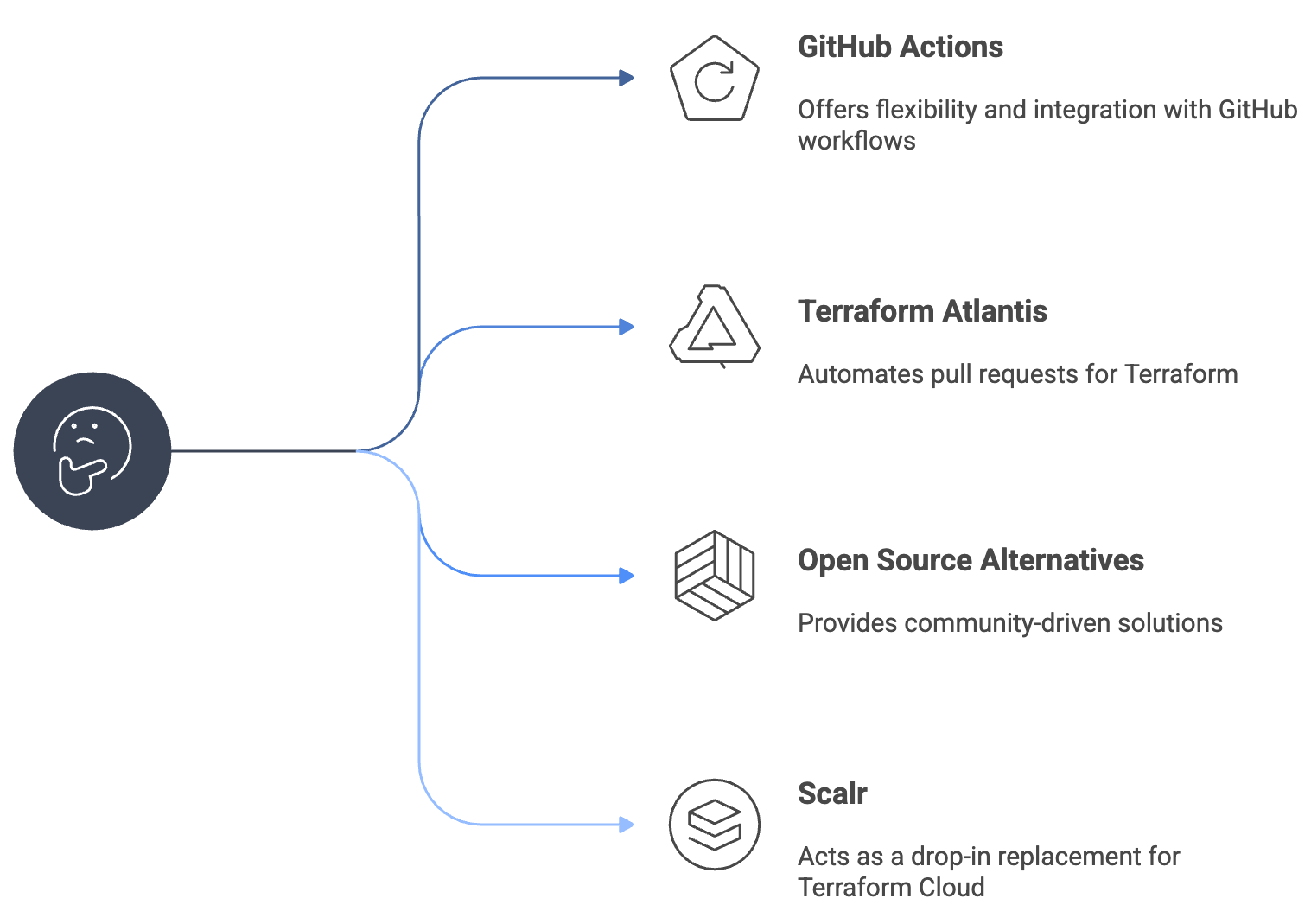Terraform Cloud Alternatives: Open Source & Github Action
There are 4 kinds of Terraform Cloud alternatives: Open Source, Github Actions, Terraform Atlantis, and drop-in replacements.
Many folks are looking for a way out of Terraform Cloud. Ever since the BSL license change in August 2023, organizations have been eyeing the exits. The reasons vary: the license, the cost, or simply the desire to run one's own stack. Whatever the reason, a GitOps workflow for Terraform (or OpenTofu) is a common requirement, often with the goal of avoiding dependency on a single commercial vendor.

The desired workflow includes plan in PRs, approvals, a clean apply on merge, state locking, and security. This is all achievable without a TFC subscription, but each alternative comes with its own trade-offs.
The options boil down to four main paths. Some are straightforward, some are complex, and one is simply a maintenance trap.
Using GitHub Actions
This is a common first idea, easy to get started, but like with Jenkins, eventually gets harder and harder to maintain until a rewrite is required.
The rationale is to leverage existing CI systems like GitHub Actions. The process begins by setting up an S3 bucket for state, a DynamoDB table for locking, and writing YAML. A first terraform plan workflow looks simple enough:
# .github/workflows/terraform-plan.yml
name: 'Terraform Plan'
on:
pull_request:
paths:
- '**.tf'
- '**.tfvars'
jobs:
terraform:
name: 'Terraform Plan'
runs-on: ubuntu-latest
steps:
- name: Checkout
uses: actions/checkout@v4
- name: Setup Terraform
uses: hashicorp/setup-terraform@v3
with:
terraform_version: 1.8.0 # Or an OpenTofu version
- name: Configure AWS Credentials
uses: aws-actions/configure-aws-credentials@v4
with:
aws-access-key-id: ${{ secrets.AWS_ACCESS_KEY_ID }}
aws-secret-access-key: ${{ secrets.AWS_SECRET_ACCESS_KEY }}
aws-region: us-east-1
- name: Terraform Init, Validate & Plan
run: |
terraform init
terraform validate
terraform plan -no-color
For a single developer on a single project, this can be fine. For a week. Then comes the need to post the plan back to the PR, handle plan artifacts so the apply job uses the exact plan that was approved, manage multiple environments, and handle approvals. This often leads to drowning in a sea of unmaintainable YAML, and teams find they've spent sprints building a fragile, half-baked version of a tool that already exists.
This is a maintenance trap. This approach should be avoided unless there is a very specific and compelling reason to choose it.
Pull Request Automation with Atlantis
Atlantis is the original open-source Terraform automation tool. It’s a self-hosted Go binary that listens for webhooks, runs plan when a PR is opened, and posts the output in a comment. To apply, an authorized user comments atlantis apply. Simple.
It defined what Terraform GitOps should feel like.
But its greatest strength—its simplicity—is now its greatest weakness. Atlantis is a single server that does everything. It runs the plans, holds the state locks, and holds cloud credentials. This is not ideal.
- It doesn't scale. Every job runs in a single thread. Busy teams will find themselves stuck in a queue.
- It's a security bottleneck. That one server holds the keys to the kingdom. If it gets compromised, it's a major incident.
- It's stagnant. Development has slowed considerably. Advanced features like drift detection or modern policy checks are not expected.
The verdict? Atlantis is a fantastic tool for small teams or for getting started. But teams often outgrow it.
Open Source Alternatives to Terraform Cloud
This is where the landscape gets more interesting. A new generation of tools figured out how to fix the Atlantis problem.
They work by running a lightweight orchestrator that listens for PR comments, just like Atlantis. But instead of running the terraform commands itself, it triggers a job in the user's existing CI system. The plan runs in a standard GitHub Actions runner.
Why is this a game-changer?
- Security. Cloud credentials never leave the CI environment. They are injected into the ephemeral runner, just like any other job. The orchestrator never sees them. The "keys to the kingdom" problem is gone.
- Scalability & Cost. It scales with the CI provider. If more concurrent runs are needed, more GitHub Actions runners are used. This avoids the cost and maintenance of a separate compute fleet.
- Digger is the lean, open-source choice here. It focuses on doing one thing well: orchestrating CI. It's easy to set up, secure by design, and gives the core GitOps workflow with modern features like OPA policy support and drift detection.
- Terrateam is the more enterprise-focused option. It's built for platform teams managing many projects, with a more robust, scalable server architecture (it needs a Postgres DB), and native support for other tools like Pulumi and Terragrunt.
Drop-in Terraform Cloud Alternative (Scalr)
For those who liked the Terraform Cloud experience but want a self-hosted option or a different security model, there's Scalr.
Scalr's main offering is a hybrid SaaS. The control plane—the UI, workspace management, policy logic—is managed SaaS. But the work happens on self-hosted agents that run in the user's own cloud environment. Credentials and state files stay within the user's network.
For organizations seeking the most direct, lowest-friction drop-in replacement for TFC/TFE, this is it. It provides an all-in-one platform experience.
Quick Comparison
Factor | DIY GitHub Actions | Atlantis | Digger | Terrateam | Scalr |
|---|---|---|---|---|---|
How it Works | User-owned scripts run in CI jobs. | Self-hosted server runs all compute. | Orchestrator triggers jobs in your CI. | Server orchestrates jobs in CI runners. | SaaS control plane with self-hosted agents. |
Security | As good as implemented. | Bad. Credentials on a central server. | Excellent. Credentials stay in CI. | Excellent. Credentials stay in CI. | Excellent. Credentials stay in self-hosted agent. |
Scalability | Poor. Complexity becomes prohibitive. | Poor. Single-threaded execution. | High. Scales with CI provider. | Very High. Horizontally scalable server. | Very High. Agent-based model scales horizontally. |
Maintenance | Very High. The team owns everything. | Medium. Maintain the server host. | Low. Orchestrator is minimal. | Medium. Server + DB. | Low. Maintain agents only. |
Best For | Niche cases with high in-house expertise. | Small teams starting out. | Teams prioritizing security & CI integration. | Platform teams at scale. | Teams wanting a direct TFC replacement. |
The Bottom Line: Which to Use?
Here are some general guidelines:
- For a solo dev or a small team just getting started, Atlantis is a solid choice. It's easy to set up and provides the core workflow. Be aware that a migration may be needed within a year or two as the team scales.
- For a team of any size that already uses GitHub Actions and cares about security, Digger is often the best fit. It has a smart architecture, providing a secure, scalable workflow for almost no operational cost. For most teams, this is the sweet spot.
- For a large platform team managing dozens of projects and multiple IaC tools, Terrateam is worth investigating. It's built for that kind of complexity, with the HA and RBAC features needed at scale.
- For teams that would be happy with Terraform Cloud, Scalr is the answer. It's the most direct drop-in replacement and provides a familiar UI-driven experience with a great security model.
Of course, pricing can be a factor too, so the following post may also help you:

Sources Used
- OpenTofu GitHub Repository: https://github.com/opentofu/opentofu
- Terrateam Documentation: https://terrateam.io/docs
- Atlantis Documentation: https://www.runatlantis.io/docs/
- Digger Documentation: https://docs.digger.dev/docs/
- Scalr Documentation: https://docs.scalr.com/


